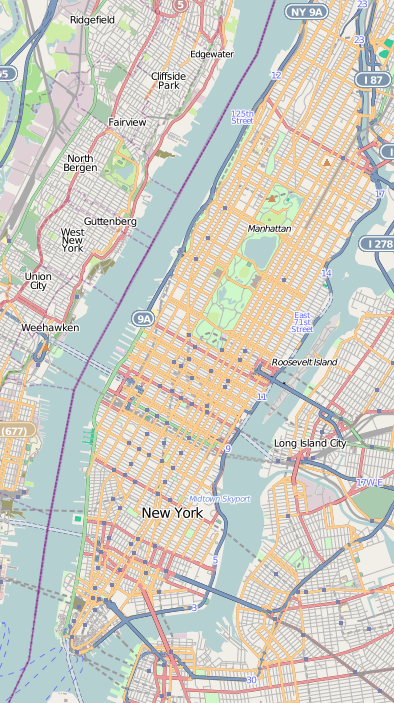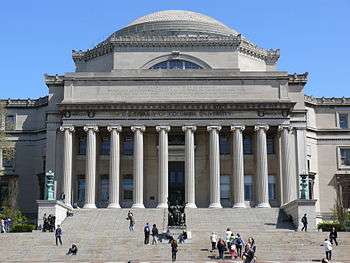Pupin Hall
Pupin Physics Laboratories /ˈpjuːpɪn/, also known as Pupin Hall, is home to the physics and astronomy departments of Columbia University in New York City. The building is located on the south side of 120th Street, just east of Broadway. In 1965, Pupin was named a National Historic Landmark for its association with experiments relating to the splitting of the atom, achieved in connection with the later Manhattan Project.[4][5][6] In 2009 the American Physical Society named Pupin Hall a historic site and honored Isidor Isaac Rabi for his work in the field of magnetic resonance.[7]
Pupin Physics Laboratory, Columbia University | |
.jpg) Pupin Hall | |
   | |
| Location | New York, NY |
|---|---|
| Coordinates | 40°48′36.23″N 73°57′41.52″W |
| Built | 1925 - 1927[1] |
| Architect | McKim, Mead, and White[1] |
| Architectural style | Renaissance inspired with colonial influence[2] |
| NRHP reference No. | 66000550 |
| Significant dates | |
| Added to NRHP | October 15, 1966[3] |
| Designated NHL | December 21, 1965 [4] |
History
Pupin Hall was built in 1925-1927 to provide more space for the Physics Department which had originally been housed in Fayerweather Hall. In 1935, it was renamed after Mihajlo Idvorski Pupin (also known as Michael I. Pupin), a Serbian-American scientist and graduate of Columbia. Returning to the university's engineering school as a faculty member, he played a key role in establishing the department of electrical engineering. Pupin was also a brilliant inventor, developing methods for rapid x-ray photography and the "Pupin coil," a device for increasing the range of long-distance telephones. After his death in 1935, the university trustees named the newly constructed physics building the "Pupin Physics Laboratories" in his honor.
By 1931, the building which later became Pupin Hall was a leading research center. During this time Harold Urey (Nobel laureate in Chemistry) discovered deuterium and George B. Pegram was investigating the phenomena associated with the newly discovered neutron. In 1938, Enrico Fermi escaped fascist Italy after winning the Nobel prize for his work on induced radioactivity. In fact, he took his wife and children with him to Stockholm and immediately emigrated to New York. Shortly after arriving he began working at Columbia University with Dr. John Dunning. His work on nuclear fission, together with I. I. Rabi's work on atomic and molecular physics, ushered in a golden era of fundamental research at the university. One of the country's first cyclotrons was built in the basement of Pupin Hall by John R. Dunning, where it remained until 2007. The building's historic significance was secured with the first splitting of a uranium atom in the United States, which was achieved by Enrico Fermi in Pupin Hall on January 25, 1939, just 10 days after the world's first such successful experiment, carried out in Copenhagen, Denmark.
Advances in research
The building is a landmark due to the advances in nuclear research made there during the Manhattan Project to develop the first nuclear weapon. It is connected to the university tunnels, from which one can occasionally access the Manhattan Project's leftover cyclotron and other historic research facilities. Sadly, many of these have been sealed off since the 1980s, when Ken Hechtman wrought havoc with nuclear materials he stole from Pupin's basement.
Other discoveries and breakthroughs achieved in Pupin include:
- The discovery of deuterium by Harold Urey
- The investigation of neutron phenomena by George Pegram
- The construction of one of the country's first cyclotrons
- January 25, 1939: the first splitting of a uranium atom in the United States, by Enrico Fermi
Features and layout quirks
The current main entrance to Pupin is on the 5th floor from the plaza above Dodge Physical Fitness Center. This means that many of the seminar rooms in Pupin on floors 2-4, while above ground, are below campus level and, therefore, windowless. The original entryway was on the first floor from the Grove, but got blocked by the construction of Dodge in the 1960s. The entryway smells like chlorine because Uris Pool has an exit stairway leading into Pupin's entry.
The Rutherfurd Observatory is on top of Pupin. The Astronomy Department hosts bi-monthly Public Observing Nights, and serves the Tri-State area in hosting people interested in observing with an optical telescope.[8]
See also
- Columbia University
- Columbia University Physics Department
- Michael I. Pupin
- I.I. Rabi
- Enrico Fermi
- National Historic Landmarks
References
- Dolkart, Andrew S. (1998). Morningside Heights: A History of its Architecture and Development. Columbia University Press. p. 354. ISBN 978-0-231-07850-4. OCLC 37843816.
- Dolkart, Andrew. Conversation with Kitty Chibnik, Columbia University, February 25, 2009
- "National Register Information System". National Register of Historic Places. National Park Service. January 23, 2007.
- "Pupin Physics Laboratory, Columbia University". National Historic Landmark summary listing. National Park Service. 2007-09-11. Archived from the original on 2012-10-10.
- "National Register of Historic Places Inventory-Nomination". National Park Service. 1983.
- "National Register of Historic Places Inventory-Nomination". National Park Service. 1983.
- "American Physical Society names Pupin Hall a Historic Site" (Press release). Columbia University. 2009-02-05. Retrieved 2009-02-27.
- Public Observing Nights
External links
- National Historic Landmarks database



